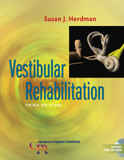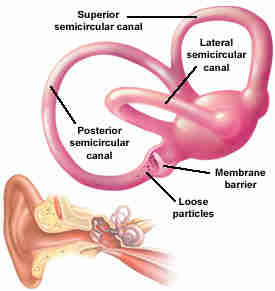Causes of dizziness
Causes of dizziness covers Susan Herdman's superb book called Vestibular Rehabilitation.
Dizzy patients quite regularly appear in the chiropractic clinic. They have heard down the health grapevine that an adjustment of the cervical spine can fix their spinning worlds.
That you would think, would please chiropractors. Yes, it does but with the prominence given to stroke after a cervical manipulation by the medical fraternity, extremely rare though it may be, many DCs have become increasingly anxious about giving that much needed adjustment to the patient suffering from vertigo.

A recent survey of 29,000 patients with neck related conditions revealed that 70% plus stated confidently that they obtained immediate relief, but 4.8 percent said that they had worsening of symptoms. An analysis of this small group showed that many had presented with dizziness.
Are there other causes of vertigo and alternative ways to manage the dizzy patient? Safer treatments; is dizziness always cervicogenic?
Susan Herdman's authoritative compilation of articles by more than twenty experts in the field, now in its third edition, is a must on every chiropractor's desk; if he or she wants to treat the patient suffering from vertigo.
Yes there is a difference between vertigo and dizziness.
Is the patient also experiencing nystagmus. Does he or she have a heart condition or an inner ear infection?
Imagine a simple set of movements that can be done in the chiropractic clinic that can safely and quickly address vertigo. Called the Epley manoeuvres, these techniques are a must in every DC's toolbox.
This is particularly true with the new emphasis on neurology in the profession.
Perhaps
even more important, a simple test called the Hallpike-Dix manoeuvre can quickly establish that this is not a patient to adjust the
upper cervicals; not initially anyway.
Now that researchers are finding many convincing
scientific explanations as to why the spinal adjustment works, there appears to
be a shift towards giving neurology more prominence in our philosophy lectures.

Chapters in this easy to read book, include:
- Anatomy and Physiology of the normal Vestibular system.
- Role of the Vestibular system in postural control.
- Migraine and Meniere's disease.
- History and clinical examination.
- Management of Benign Paroxysmal Positional Vertigo (BPPV).
- And much more.
This is a book that one can dip into; easily find what is useful and relevant to the chiropractor. Well laced with easy to follow pictures, this is one of the best texts that I have bought in recent years. I wouldn't be without it on my shelf.
Hypertension
Clearly the hypertensive patient is one to treat with the utmost discretion. Initially using an activator tool is more advisable rather than a frank adjustment.
Oliveros et al estimated that fully one third of the adult population worldwide will suffer from hypertension by 2025. It is the leading risk factor for cardiovascular disease
But are there well researched ways to lower blood pressure naturally? Much to everyone's surprise in fact a simple set of isometric quadriceps exercises are the most effective.
Add to that dark-green leafy vegetables, known for their dietary nitrates that reduce stiffening of the arteries, lower blood pressure and inhibit platelet aggregation. For the patient determined to enjoy a life without medication certain lifestyle changes have huge benefit. Spinach, rocket salad and beets in particular have proven value.
Causes of dizziness
Causes of dizziness are legend; this is a must on every chiropractor's bookshelf.
When browsing these links use right click and "Open Link in New Tab", or you may get a bad gateway signal.
Did you find this page useful? Then perhaps forward it to a suffering friend. Better still, Tweet or Face Book it.
